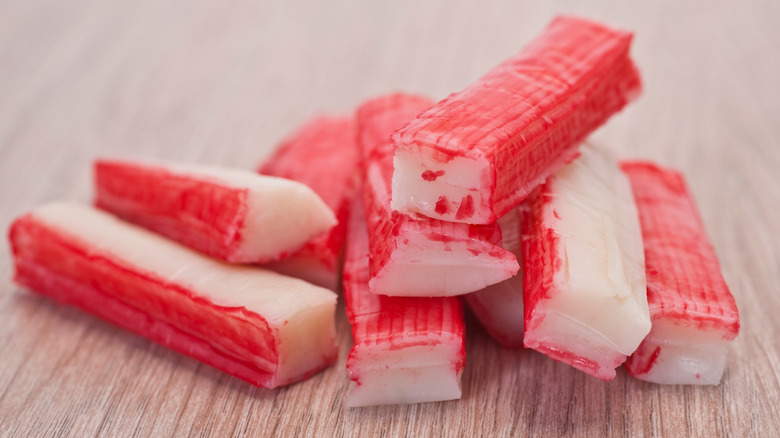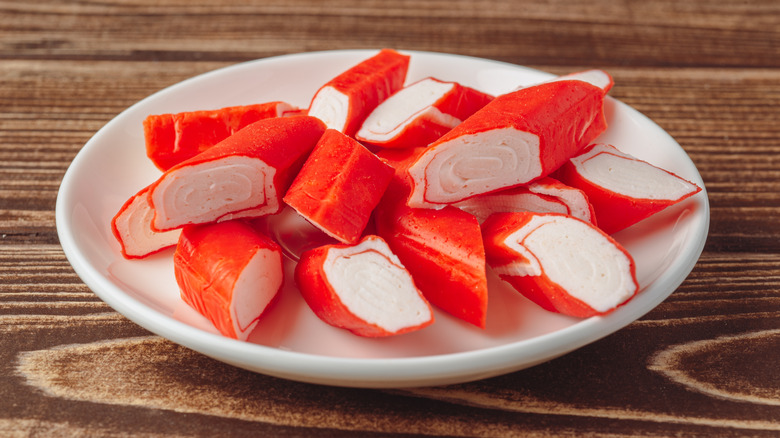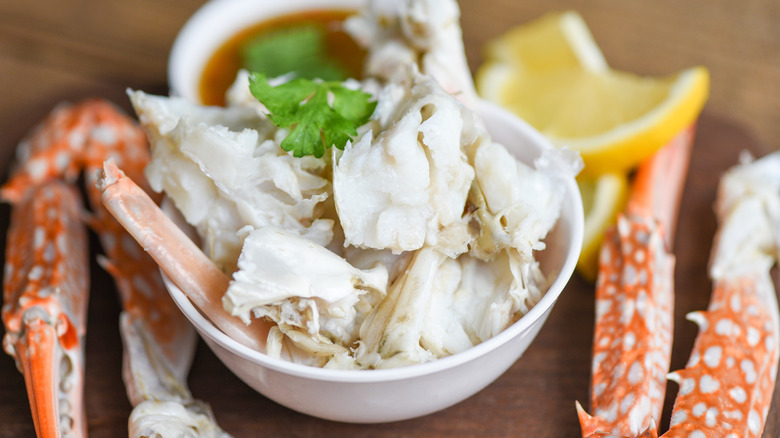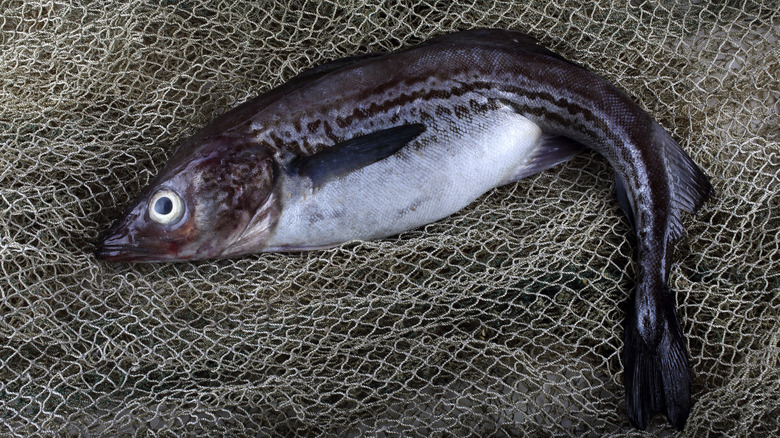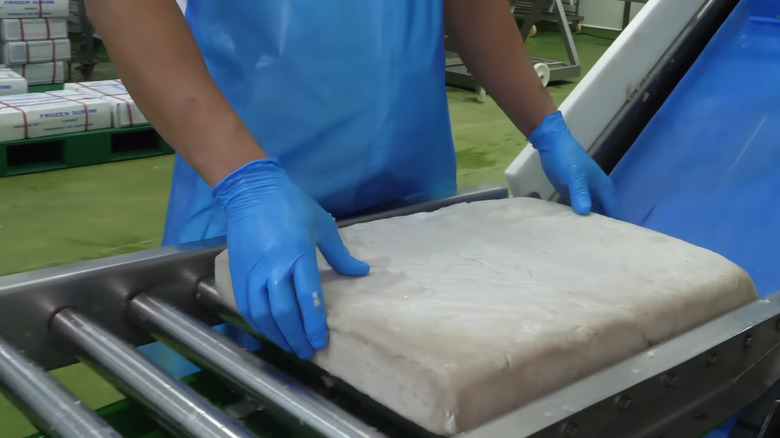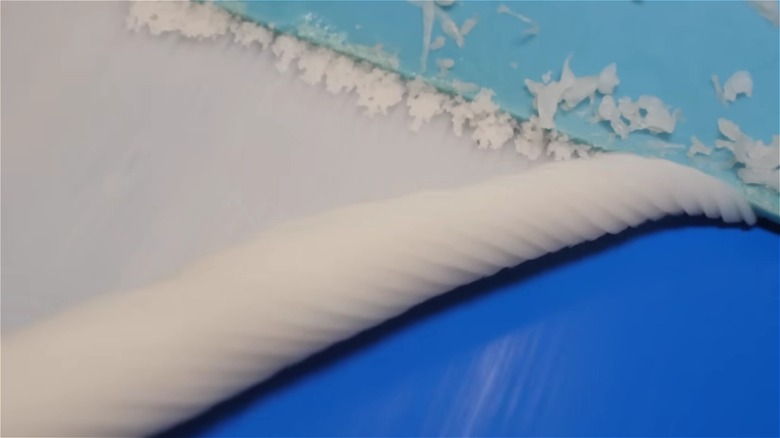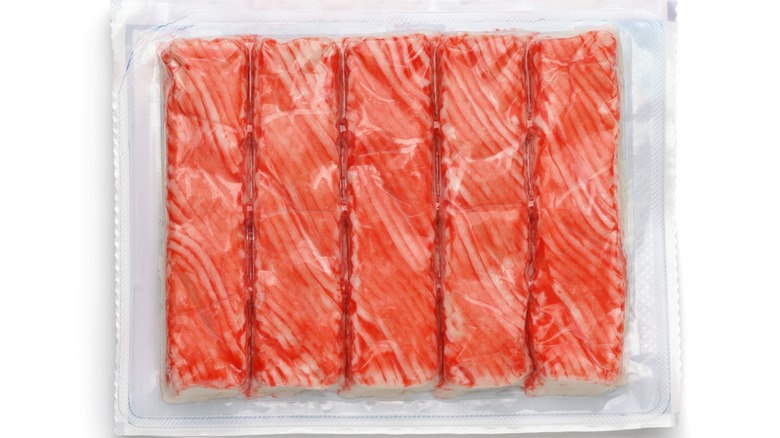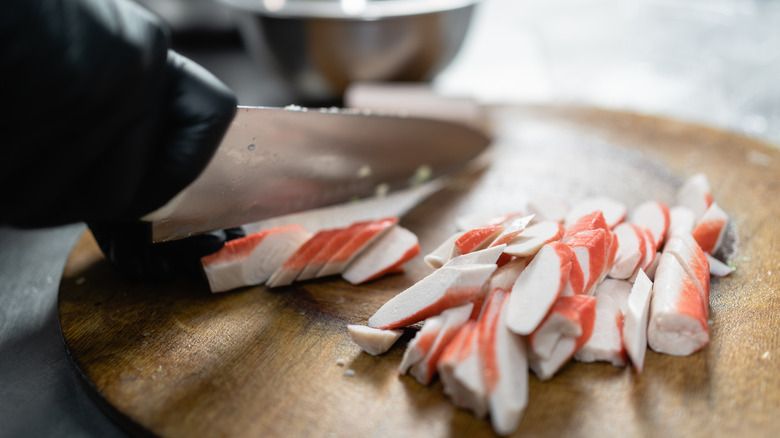This Is How Imitation Crab Is Actually Made
Imitation food is an umbrella term used to describe food that has been manipulated to look like something else. In one form or another, imitation foods have been made for centuries as a means of surprising and delighting those eating. For example, raw vegetables have long been carved to resemble flowers. Imitation foods have also been used to help those who are going without to still enjoy their food; medieval chefs even created imitation meat dishes using ingredients like fish to replace pork and beef products during days when eating meat was prohibited.
Imitation products, including imitation crab, also offer a cheap alternative to expensive foods. In this instance, imitation crab allows those unable to purchase actual crab — whether for economic or geographic reasons — the opportunity to eat a close approximation of it. It also allows those who want to eat crab without contributing to the environmental pressures placed on the animals to do so.
As a cheap, mass-produced alternative to crab meat, imitation crab is widely used in the modern food system, appearing in everything from grocery store sushi to crab salads. Despite this, many Americans turn their noses up at imitation crab, assuming that it is an entirely artificial, and therefore unhealthy, product. This opinion stems from widespread ignorance concerning how imitation crab is actually made. Rest assured, it's not as bad as many people assume.
What is imitation crab?
Imitation crab is not a completely artificial food product. Imitation crab is predominately made from surimi, a fish-based paste that was first created by Japanese chefs during the 12th century. At this time, excess surimi was made by salting and grinding up excess fish to preserve it. Modern surimi is still made from ground-up fish flesh but, thanks to the addition of other ingredients and processes, it is much more stable. This allows it to be formed into a product that resembles crab meat in terms of both flavor and texture. Slightly changing these additions and processes also allows surimi to be transformed into various other products, like imitation lobster or imitation scallops.
Alaska pollock is the fish most often used to make surimi, and consequently, imitation crab. This mild, white fish is not popular when sold under its own name. As a result, it stands as a sustainable source of fish thanks to its natural abundance.
When customers learn that surimi and imitation crab are often made from wild-caught fish, their opinion of the product seems to change for the better. Craig Morris, CEO of the Association of Genuine Alaska Pollock Producers highlighted this in a release from the organization: "Excitingly, the research unequivocally shows that learning that surimi seafood is made with Wild Alaska Pollock seems to improve the already favorable impressions these consumers have about surimi."
Imitation crab vs. crab meat
As we've seen, imitation crab is made from ground-up fish flesh, usually Alaska pollock. This marks it as distinctly different from actual crab meat, which is (of course) sourced from a variety of crab breeds. Due to this integral difference, imitation crab and crab meat have distinct nutritional profiles. Around 100 grams of imitation crab contains roughly 7 grams of protein. That's around 10 grams less than is found in 100 grams worth of regular crab meat.
Additionally, a 100-gram serving of imitation crab meat contains over 15 grams more carbohydrates, more sugar, and less calcium when compared to real crab meat. In terms of the amount of beneficial vitamins and minerals it contains, imitation crab also falls short — containing less zinc, magnesium, and phosphorus (to name a few) — than real crab.
While nutritionally inferior, using imitation crab in place of crab meat does have its benefits. Most notably, imitation crab usually costs about 66% less than regular crab meat. What's more, imitation crab draws upon abundant Alaska pollock fisheries. Crab population collapses and associated fishery closures — as have been seen in Alaska in 2023 – are indications to some that current crab fishery methods are not sustainable. For these people, imitation crab appears as a sustainable and attractive alternative to regular crab meat.
First, the fish must be caught and cleaned
The first step in making some imitation crab is catching the fish. As previously noted, Alaska pollock is the preferred species. This fish is found across the North Pacific Ocean in great quantities. All of the Alaska pollock populations with requisite data have been found to be sustainably managed and not overfished. For these reasons, the National Oceanic and Atmospheric Administration has named the species a smart seafood choice. It is one of many fish that are recommended for eco-conscious consumption due to its responsible and sustainable handling.
In United States fisheries, Alaska pollock is caught by trawling (pulling a large, open fishing net through) the water. Despite the large nets that are used, the by-catch (the accidental catching of other species) is minimal. The National Oceanic and Atmospheric Administration estimates that by-catch stands at 1% of the total catch. Various systems are in place to ensure by-catch remains low and that natural phenomena, including the salmon run, are not impacted by Alaska pollock fishing.
After being caught, the fish must be prepared. This can be done either on the boat or back on land at large-scale processing facilities. Regardless of where it takes place, all fish are processed by the same means. They are gutted, scaled, and filleted before being thoroughly washed. At this point, the fish is ready to be transformed into surimi.
Then, the fish is transformed into surimi
The cleaned filets are transformed into surimi during the deboning process. If done by hand, the flesh is cleaved from the bones before being shredded. Deboning machines work much quicker, separating the flesh from the bones and skin by pressing it against a fine-meshed drum. Due to it being pressed through tiny holes, the flesh is simultaneously freed from the carcass and processed into a fine paste.
This paste is subsequently washed multiple times to rid it of any water-soluble particles before being processed further. Matthieu, a professional flavorist, explained the process to Vice: "The fish meat is shredded, rinsed over and over in freshwater, then pressed until it turns into an odourless and tasteless paste. We call it 'surimi base'."
Before pressing, the paste is mechanically sorted by color and texture allowing for each batch of surimi to be made from uniform pieces of meat. After sorting, the meat is pressed to remove any excess water. This helps the meat retain its texture while frozen.
Next, ingredients are added to the surimi and it is frozen
After pressing to remove all the water, ingredients including sugar and sorbitol are added to the surimi paste. These ingredients allow the paste to be frozen without losing any of its properties through a variety of means. Most easily understandable is the role sugar plays; higher concentrations lower the surimi's freezing temperatures. This, in turn, helps prevent the formation of large ice particles which would destroy the surimi's smooth texture.
Thanks to the addition of these ingredients, surimi is frozen at temperatures below 4 degrees Fahrenheit, usually in blocks that weigh 22 pounds, reports How Products Are Made. In this form, surimi can last for around one year. This stabilizing and freezing process was only perfected in the late 20th century. Avoiding the loss of surimi's characteristics and increasing its shelf life played a direct role in imitation crab and other surimi-based products becoming globally popular. Nowadays, such a long shelf life and non-extreme temperatures mean it's simple to ship surimi around the world.
Surimi is then manipulated to achieve a crab-like texture
The surimi base is subsequently formed into imitation crab. This requires various steps. Firstly, the frozen, 22-pound blocks of surimi are warmed and sliced into flakes. These flakes are then mixed with a variety of other ingredients including starch and egg whites. These ingredients are added to develop the surimi's texture, making it more robust and similar to real crab meat. Other ingredients, including salt and flavorings, are also added at this point to make the surimi taste similar to crab meat. Occasionally, real crab meat is even added to the mixture.
After mixing, the resulting paste is formed into sheets and cooked. The firm, cooked surimi sheets are then sliced into thin strands which are bundled together to form a rope-like mass, designed to mimic the formation and texture of real crab meat.
Despite these steps, it is impossible to exactly replicate crab meat's texture, as Jade Silverstein, a sustainable seafood consultant, highlighted to Parade: "Imitation crab looks and cooks just like crab meat, but its texture is slightly different, often smoother and denser than actual crab meat."
Finally, the imitation crab is cooked and made more visually appealing
The bundles of surimi are then colored. This is simply for visual appeal, with colors being used to indicate the surimi's flavor. In his interview, professional flavourist Matthieu explained to Vice: "The colour is just for visual recognition. It's a big part of its identity. In France, Belgium and Italy, the sticks are orange because they're crab-flavoured. But in the rest of the world, they're often more pink or red and they can be flavoured with clam or lobster."
Once colored, the imitation crab is cut to size. How they are cut will depend on what the imitation crab's final form will be. If being sold as flakes, the imitation crab will be finely cut. More popular, however, are crab sticks, which adopt a long thin form to mimic meat harvested from crab legs.
After being cut, the imitation crab is cooked again. Various cooking methods can be used, each affecting the imitation crab's final texture. Steaming is among the most common and results in a finished product that closely resembles real crab meat. The finished product is then packaged, shipped, and sold. Often, the product undergoes these processes while frozen to prolong its shelf life.
How long does imitation crab last?
Once purchased, imitation crab can last for a long time, provided it is purchased frozen and remains so until cooking. Many imitation crab products can last for around one year in a home freezer. However, after defrosting, they should be refrigerated and consumed within 72 hours.
If refrigerated imitation crab is purchased, its shelf life is dramatically shorter; this product only lasts between three to five days when stored in the refrigerator. Unfrozen Imitation crab that's left outside of the refrigerator lasts an even shorter amount of time and should not be consumed after more than two hours have passed.
Imitation crab recipes
As a cheap, versatile, and sustainable food product, imitation crab is something every home cook should know how to use. A great starting point for those unfamiliar with imitation crab is imitation crab and egg salad. This recipe requires only the most basic of cooking expertise and results in a strongly flavored, protein-packed, moreish salad that makes for an excellent sandwich filling.
Two further recipes demonstrate how easy and effective it is to substitute real crab meat for imitation crab. The first of these, an imitation crab meat crab cake, reveals how this iconic dish can be made cheaply and sustainably with imitation crab. The resulting crab cakes are both hearty and flavorful.
Crab linguine is another classic that's usually made with these expensive crustaceans. An imitation crab linguine offers a simple and effective alternative, spotlighting diced imitation crab meat in a weeknight staple the whole family will enjoy.
